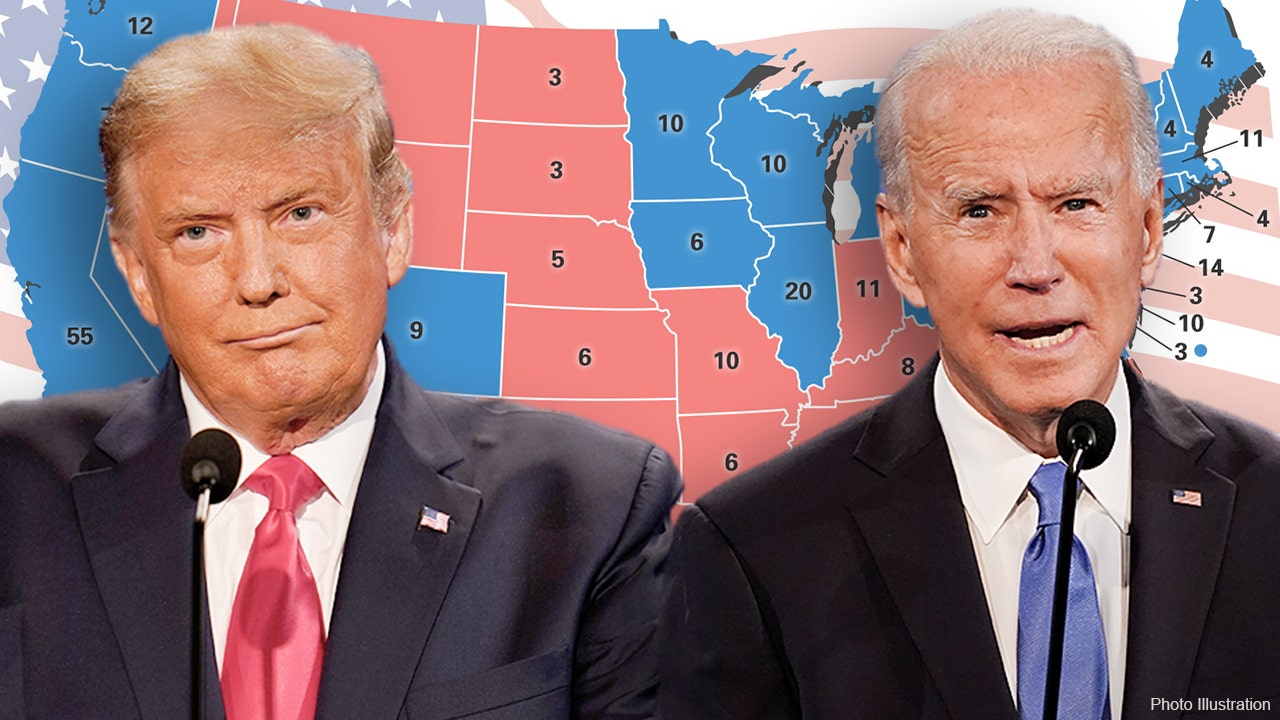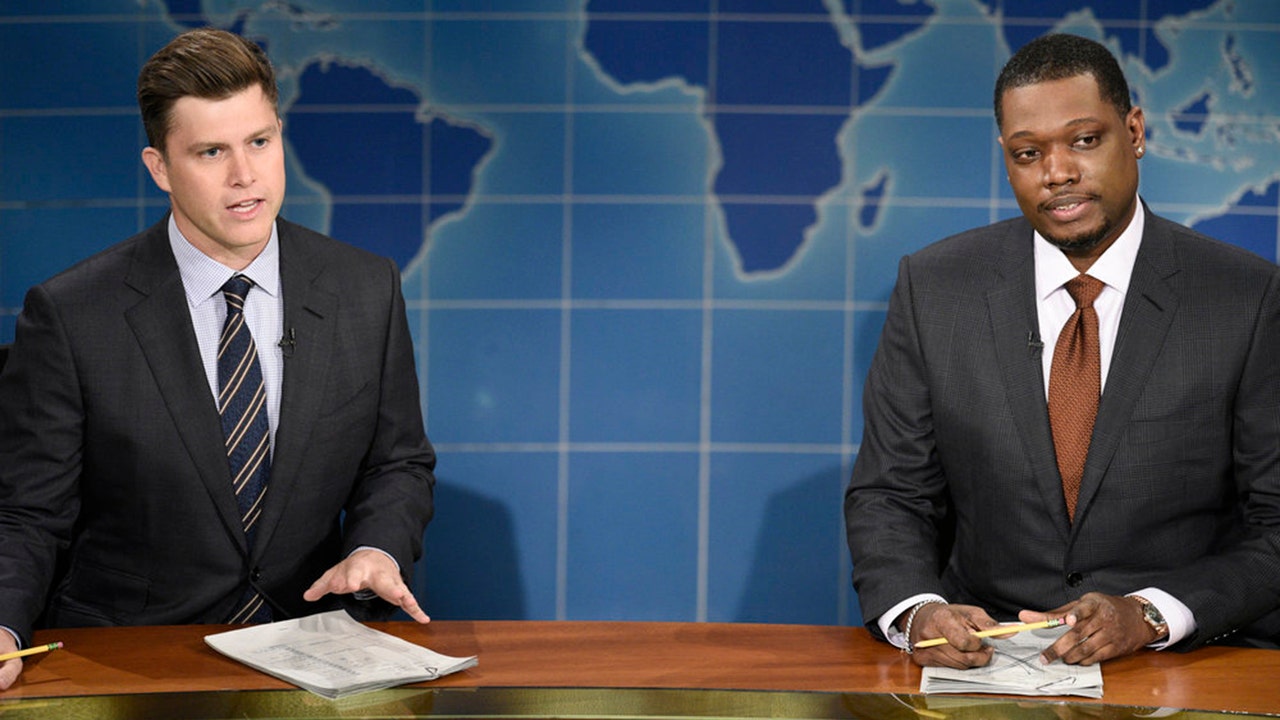The graves were discovered, vandalized, hours before Trump made his final stop at Grand Rapids late Monday.

— FOX News

The graves were discovered, vandalized, hours before Trump made his final stop at Grand Rapids late Monday.

— FOX News

The sites are key conduits for communication and information. Here’s how they plan to handle the challenges facing them before, on and after Tuesday.

Facebook, YouTube and Twitter were misused by Russians to inflame American voters with divisive messages before the 2016 presidential election. The companies have spent the past four years trying to ensure that this November isn’t a repeat.
They have spent billions of dollars improving their sites’ security, policies and processes. In recent months, with fears rising that violence may break out after the election, the companies have taken numerous steps to clamp down on falsehoods and highlight accurate and verified information.
We asked Facebook, Twitter and YouTube to walk us through what they were, are and will be doing before, on and after Tuesday.
Since 2016, Facebook has poured billions of dollars into beefing up its security operations to fight misinformation and other harmful content. It now has more than 35,000 people working on this, the company said.
One team, led by a former National Security Council operative, has searched for “coordinated inauthentic behavior” by accounts that work in concert to spread false information. That team, which delivers regular reports, will be on high alert on Tuesday. Facebook has also worked with government agencies and other tech companies to spot foreign interference.
To demystify its political advertising, Facebook created an ad library so people can see what political ads are being bought and by whom, as well as how much those entities are spending. The company also introduced more steps for people who buy those ads, including a requirement that they live in the United States. To prevent candidates from spreading bad information, Facebook stopped accepting new political ads on Oct. 20.
At the same time, it has tried highlighting accurate information. In June, it rolled out a voter information hub with data on when, how and where to register to vote, and it is promoting the feature atop News Feeds through Tuesday. It also said it would act swiftly against posts that tried to dissuade people from voting, had limited forwarding of messages on its WhatsApp messaging service and had begun working with Reuters on how to handle verified election results.
Facebook has made changes up till the last minute. Last week, it said it had turned off political and social group recommendations and temporarily removed a feature in Instagram’s hashtag pages to slow the spread of misinformation.
On Tuesday, an operations center with dozens of employees — what Facebook calls a “war room” — will work to identify efforts to destabilize the election. The team, which will work virtually because of the coronavirus pandemic, has already been in action and is operating smoothly, Facebook said.
Facebook’s app will also look different on Tuesday. To prevent candidates from prematurely and inaccurately declaring victory, the company plans to add a notification at the top of News Feeds letting people know that no winner has been chosen until election results are verified by news outlets like Reuters and The Associated Press.
Facebook also plans to deploy, if needed, special tools that it has used in “at-risk countries” like Myanmar, where election-related violence was a possibility. The tools, which Facebook has not described publicly, are designed to slow the spread of inflammatory posts.
After the polls close, Facebook plans to suspend all political ads from circulating on the social network and its photo-sharing site, Instagram, to reduce misinformation about the election’s outcome. Facebook has told advertisers that they can expect the ban to last for a week, though the timeline isn’t set in stone and the company has publicly been noncommittal about the duration.
“We’ve spent years working to make elections safer and more secure on our platform,” said Kevin McAlister, a Facebook spokesman. “We’ve applied lessons from previous elections, built new teams with experience across different areas and created new products and policies to prepare for various scenarios before, during and after Election Day.”
Twitter has also worked to combat misinformation since 2016, in some cases going far further than Facebook. Last year, for instance, it banned political advertising entirely, saying the reach of political messages “should be earned, not bought.”
At the same time, Twitter started labeling tweets by politicians if they spread inaccurate information or glorify violence. In May, it added several fact-checking labels to President Trump’s tweets about Black Lives Matter protests and mail-in voting, and restricted people’s ability to share those posts.
In October, Twitter began experimenting with additional techniques to slow the spread of misinformation. The company added context to trending topics and limited users’ ability to quickly retweet content. The changes are temporary, though Twitter has not said when they will end.
The company also used push notifications and banners in its app to warn people about common misinformation themes, including falsehoods about the reliability of mail-in ballots. And it expanded its partnerships with law enforcement agencies and secretaries of state so they can report misinformation directly to Twitter.
In September, Twitter added an Election Hub that users can use to look for curated information about polling, voting and candidates. The company has said it will remove tweets that call for interference with voters and polling places or intimidate people to dissuade them from voting.
“The whole company has really been mobilized to help us prepare for and respond to the types of threats that potentially come up in an election,” said Yoel Roth, Twitter’s head of site integrity.
On Tuesday, Twitter’s strategy is twofold: Root out false claims and networks of bots that spread such information by using both algorithms and human analysts, while another team highlights reliable information in the Explore and Trends sections of its service.
Twitter plans to add labels to tweets from candidates who claim victory before the election is called by authoritative sources. At least two news outlets will need to independently project the results before a candidate can use Twitter to celebrate his or her win, the company said.
People looking for updates on Tuesday will be able find them in the Election Hub, Twitter said.
Twitter will eventually allow people to retweet again without prompting them to add their own context. But many of the changes for the election — like the ban on political ads and the fact-checking labels — are permanent.
For Google’s YouTube, it wasn’t the 2016 election that sounded a wake-up call about the toxic content spreading across its website. That moment came in 2017 when a group of men drove a van into pedestrians on London Bridge after being inspired by YouTube videos of inflammatory sermons from an Islamic cleric.
Since then, YouTube has engaged in an often confusing journey to police its site. It has overhauled its policies to target misinformation, while tweaking its algorithms to slow the spread of what it deems borderline content — videos that do not blatantly violate its rules but butt up against them.
It has brought in thousands of human reviewers to examine videos to help improve the performance of its algorithms. It has also created a so-called intelligence desk of former analysts from government intelligence agencies to monitor the actions of foreign state actors and trends on the internet.
Neal Mohan, YouTube’s chief product officer, said that he held several meetings a week with staff to discuss the election, but that there was no last-minute effort to rewrite policies or come up with new approaches.
“Of course, we’re taking the elections incredibly seriously,” he said in an interview. “The foundational work that will play a really major role for all of this began three years ago when we really began the work in earnest in terms of our responsibility as a global platform.”
Before Tuesday, YouTube’s home page will also feature links to information about how and where to vote.
On Tuesday, Mr. Mohan plans to check in regularly with his teams to keep an eye on anything unusual, he said. There will be no “war room,” and he expects that most decisions to keep or remove videos will be clear and that the usual processes for making those decisions will be sufficient.
YouTube said it would be especially sensitive about videos that aimed to challenge the election’s integrity. YouTube does not allow videos that mislead voters about how to vote or the eligibility of a candidate, or that incite people to interfere with the voting process. The company said it would take down such videos quickly, even if one of the speakers was a presidential candidate.
As the polls close, YouTube will feature a playlist of live election results coverage from what it deems authoritative news sources. While YouTube would not provide a full list of the sources, the company said it expected the coverage to include news videos from the major broadcast networks, as well as CNN and Fox News.
Starting on Tuesday and continuing as needed, YouTube will display a fact-check information panel above election-related search results and below videos discussing the results, the company said. The information panel will feature a warning that results may not be final and provide a link to real-time results on Google with data from The A.P.
Google has said it will halt election advertising after the polls officially close. The policy, which extends to YouTube, will temporarily block any ads that refer to the 2020 election, its candidates or its outcome. It is not clear how long the ban will last.
— New York Times: Top Stories
— Mike Isaac, Kate Conger and

Did Christmas come early this year?

— FOX News

Christian actor and filmmaker Kirk Cameron said people of faith across the nation are realizing “socialism and communism are knocking on our doors.”

— FOX News

Doesn’t seem like it has.

You remember the legal horror show called Bush v. Gore? The Supreme Court couldn’t possibly replicate that. But don’t underestimate the justices’ capacity for self-inflicted wounds. The sequel’s being scripted and it may be worse.
Twenty years ago, the court stepped in to halt a recount in the disputed 2000 presidential election. Both the Constitution and federal law specifically entrusted Congress to resolve such a deadlock. But the justices recklessly inserted themselves anyway. The fiercely divided ruling cost the court its legitimacy and hurt the country.
Now there are widespread worries that the court will jump in again. “I think this will end up in the Supreme Court,” President Trump said in late September. Having just placed Amy Coney Barrett, the sixth Republican-appointed justice on the court, he is evidently thrilled about that prospect.
Only two justices remain on the court who were there in 2000 — Clarence Thomas and Stephen Breyer. Have they and their fellow justices learned anything from the court’s misadventure?
— New York Times: Top Stories

Progressivism will gain momentum in the Democratic Party if Joe Biden loses the election, Fox Nation host Lawrence Jones said on Sunday.

“Being on the campaign trail, I’ve been talking about this for a minute about the progressive side of the Democratic Party. They’re not too happy, especially when they feel like Bernie was robbed. Now, I’m not talking about from a voting standpoint, but, as you guys remember in the second quarter of this, a lot of the party elders, including President Obama, came out and kind of pushed some of the moderates out of the race and said, ‘you know, if you are not careful then we’re going to have Bernie Sanders win this thing,’” Jones told “Fox & Friends.“
Jones said that a lot of progressives “feel robbed from that standpoint.” Jones added that progressives have uprooted establishment-associated Democrats from congressional seats, beyond the victory by Rep. Alexandria Ocasio-Cortez in New York.
“When it comes to the energy on the ground, Dems are in a difficult position because these people have the energy. When you look at Corey Bush who took out [Rep. William Lacy Clay] in Missouri, or you look at what happened to [Rep. Eliot Engel] who was primaried in New York City,” Jones said.
”It’s not just AOC anymore, there are a lot of progressives that are going to be coming to Congress as well as in those state seats as well, so they are in a complicated position.”
Jones reacted to a New York Post article about how progressives will attempt to infiltrate the Democratic Party if 2020 Democratic presidential hopeful Joe Biden loses the election.
“Progressives, socialists and Bernie Bros are gearing up for war should Joe Biden fall short of his quest to unseat President Trump in Tuesday’s election,” The Post reported.
“You would see a complete repudiation of the Democratic establishment as we know it,” said Jabari Brisport, 33, a Democratic Socialist-backed candidate for state Senate expected to easily win a Brooklyn seat next week. “The Democratic establishment is not working for everyday people.”
Jones said that Tea Party members felt left behind after the Republican Party establishment continued to lose elections. He said that progressives will also “feel left behind.”
“These people weren’t ideologues, these people just wanted to have smaller government and they like the party had left them behind,” Jones said about the Tea Party.
“Expect that to happen if Joe Biden loses this race because, you know, this is the last shot for that establishment, we gave you your shot the last two elections. The third time, I don’t think they’re going to be given.”
— FOX News

Many Americans have lost the comfortable bliss of not paying attention to politics.

What did we talk about before Donald Trump? What will we talk about after Donald Trump? Will there even be an after? And was there ever really a before?
One summer day five years or a millennium ago, a boorish TV businessman, a B-list personality with a taste for the tabloid, announced one of those publicity-stunt bids for the presidency you usually hear about only in jokey montages at the end of the local news. Then, somehow, there was a catch in the fabric of time. Maybe we’d misused our technology or maybe it was cosmic retribution for our decadence, or maybe just a bad roll of the dice. Whatever it was, that day our collective attention became fixed upon this one man, and there we have remained ever since. We are stuck in eternal orbit around an expanding black hole, irresistibly sucked in.
His pull grows stronger with each turn of a relentless feedback loop: The more we look, the more he turns us off; the more he turns us off, the more we look. By the time of his inauguration, Trump was already one of the most covered, most discussed, most famous living human beings of all time.
That was only the beginning; each day since, he has come to dominate more of our lives. Now you hear from him anywhere, everywhere, at any time. He’s there on every screen and status update, in every conversation, dream, nightmare. As subtext, he lurks within the arts, in sports, in the weather reports, in houses of worship. For some of us, hardly an hour goes by in which we are not forced to think about the person occupying the White House. Even now, on the precipice of an election that may finally offer an exit from this infinite loop, the end of having to think about Trump seems nowhere close.
Sometimes I wonder about the opportunity cost of all this. If you could count up the time and energy we have spent considering this single person, how much global productive capacity would it amount to? What could we have done instead with all that attention? And what do we have to show for it?
I am no Trump fan, so I am tempted to say it’s all been a waste. I’d like to say that the biggest loss we have experienced under Trump is just this — the loss of our attention, a quiet focus that may otherwise have been put to use fixing one of the planet’s many terrible woes. In the closing days of the presidential campaign, Trump’s insatiable appetite for attention, and our inability to resist feeding it, has even become an argument against his re-election. Two-thirds of Americans report feeling “worn out” by the news. If Joe Biden wins, “it just won’t be so exhausting,” Barack Obama said at a rally the other day. “You might be able to have a Thanksgiving dinner without having an argument.”
That would be nice; I am as excited as anyone for a boring president.
Yet when I got to thinking about how Trump has redirected our attention, I realized I was mistaken. All the time we spent focused on him has not been for nothing; there has been an unexpected upside to his omnipresence. Even as Trump’s presidency has been tiring — not to mention profoundly cruel, deadly and embarrassing for our nation — it has also been something else: motivating.
With nearly every tweet, Trump gave us a new 10-car pileup from which we couldn’t look away. But in the process of making us look at him, Trump forced many of us to actually look for the first time. By turning us into a nation of rubbernecks, he has pushed us to reckon with why things are crashing in the first place and to examine the faulty infrastructure of our democracy.
If we’re lucky, this will be his only lasting legacy. For many of us, Trump has shattered the comfortable bliss of not having to pay attention.
Trump got us to recognize a truth long ignored in American politics: that a competent government is important. American greatness and American goodness can never again be taken for granted. His inept reign has proved that the country cannot run on autopilot, and there is no longer any basis for the lazy idea that America will always, in some automatic and reflexive way, “work things out.”
Trump’s gutting of federal agencies, from the Environmental Protection Agency to the State Department to the Centers for Disease Control and Prevention, proved, through their resulting failures and missteps, the importance of governmental capacity and competence. It is now tragically clear what happens if the federal government is left to wither, if expertise and experience is undermined and overruled, and if honesty, decency, integrity and fairness are abandoned by public officials: People die, people lose their jobs, hate and mistrust fester, long-term problems become sudden emergencies, and the country steadily loses unity and moral standing.
It’s difficult to remember now, but before Trump, to a lot of Americans much of what the federal government did could be relegated to an incidental corner of life. Sure, politics was a blood sport on Twitter and cable TV, but for those other than politics junkies, the Obama years were defined by a deep complacency and cynicism toward the democratic process. The midterm elections of 2010 and 2014 and the presidential races of 2012 and 2016 were low-engagement, low-turnout affairs. You might even say that American political life in the past decade has been determined more by the inaction of those who didn’t participate than by the actions of those who did.
Obama frequently called on Americans to rise above political apathy. Yet beyond his own campaigns, his policies rarely generated mass enthusiasm for the political process. His was an administration of incremental progress, averted disaster and quiet competence. Those are salutary goals, but as Trump would say, they’re boring — it’s difficult to prompt much excitement about the recession that didn’t turn into a depression, the health care plan that solved some problems but not others or the pandemic that wasn’t a national catastrophe.
From Day 1, there was nothing quiet or incremental about Trump. He attacked American institutions frontally and clamorously, shocked us into realizing their fragility and compelled us to stand up against his wrecking ball.
The backlash was swift. When Trump attacked the media, people subscribed in droves. Even as he made moves to dismantle Obamacare, the law remained as popular as it had ever been, scuttling the effort to repeal it. When Trump spewed racist ideas from the White House, many Americans recoiled. For the first time, more Americans now favor expanding immigration instead of restricting it, and a majority of Americans say they support Black Lives Matter. The more that Trump has pushed white identity politics, the less popular it has become.
It wasn’t just public opinion that shifted. The backlash prompted political action. In 2018, a wave of candidates across the country, a lot of them women and people of color, ran for office for the first time. Nearly 120 million Americans voted that year, the highest turnout for the midterms in more than 100 years. This year’s vote could shatter all records. Already, the number of people voting early has far surpassed 2016’s early voting turnout; experts say overall turnout could reach the highest rate since the election of 1908.
Then there are the other, less direct ways Trump has shaken us out of complacency. Would the #MeToo movement have had the same impact if we hadn’t elected a president who had been accused repeatedly of sexual assault? Would lawmakers have begun questioning the role that tech companies play in our lives if the man in the White House hadn’t been a geyser of social media-fueled misinformation? Would Democrats be talking about far-reaching reforms for our democracy — eliminating the Electoral College, expanding the Supreme Court, statehood for the District of Columbia and Puerto Rico — if we weren’t shocked by the dreadful chief executive this broken system has given us?
I don’t think so, at least not to the degree we are now. The Trump years have been among the most disastrous in recent American history. But they weren’t for naught. One day, inshallah, we will look back on this time as the beginning of the great American awakening.
— New York Times: Top Stories
— Columnist Farhad Manjoo

“Saturday Night Live” aired its final “Weekend Update” segment before the 2020 Election Day where it debuted host Colin Jost’s new wedding ring and took direct shots at President Donald Trump.

— FOX News

“Borat 2” star Sacha Baron Cohen donated $100,000 to the church of a woman tricked into being in the movie who was hailed by fans as its breakout star.

— FOX News

President Trump plans four stops in Pennsylvania on Saturday, and Joe Biden will give a speech in Philadelphia on Sunday.

The President will hold four rallies across Pennsylvania on Saturday and his wife, Melania, will host a fifth event in the swing state, as both the president and his Democratic challenger, Joseph R. Biden Jr., zero in on what could be a linchpin in the race for the White House.
Mr. Trump prevailed in Pennsylvania in 2016 by less than 45,000 votes, and his itinerary on Saturday suggests some of the key demographic and geographic ingredients that he hopes to combine to create another surprise victory.
His first stop is in suburban Bucks County, where Hillary Clinton prevailed in 2016 by less than one percentage point. He will hold two events outside the major media markets, in Reading and in tiny Montoursville (population around 4,400), as he seeks to drive up turnout among the white, working-class and rural voters who overwhelmingly supported him four years ago.
He will also campaign in Butler, in western Pennsylvania, where he hopes his unabashed pro-fracking message holds sway. Melania Trump, meanwhile, will appear in Luzerne County in northeastern Pennsylvania, a historically Democratic region that Mr. Trump flipped into the Republican column in 2016.
The Trumps will hardly have the state to themselves in the last days before Tuesday.
On Sunday, Mr. Biden will deliver one of his final speeches of the campaign in Philadelphia, the state’s biggest media market. And on Monday, both Mr. Biden and his running mate, Senator Kamala Harris of California, will “fan out across all four corners of the state” with their spouses on the last full day of campaigning before voters head to the polls, according to the Biden campaign.
Mr. Biden, who represented neighboring Delaware in the Senate for decades, has long considered Pennsylvania something of a second home state, given the media market overlap and his own often-cited roots in Scranton, where he was born. He delivered his campaign kickoff speech in Philadelphia in May 2019; coming full circle, his Sunday speech, which his campaign says will be about “bringing Americans together to address the crises facing the country,” will occur in the same city.
Mr. Trump will return to Pennsylvania on Monday for an event near Scranton, with other stops in North Carolina, Wisconsin and Michigan.
In 2016, Mr. Trump flipped three Rust Belt states that had been reliably Democratic by fewer than 80,000 votes in total: Michigan, Wisconsin and Pennsylvania. And while polls have him trailing Mr. Biden in all three states, Pennsylvania has been the least Democratic-leaning in surveys this year, and its 20 Electoral College votes make it the biggest prize of the three.
— NYT: Top Stories